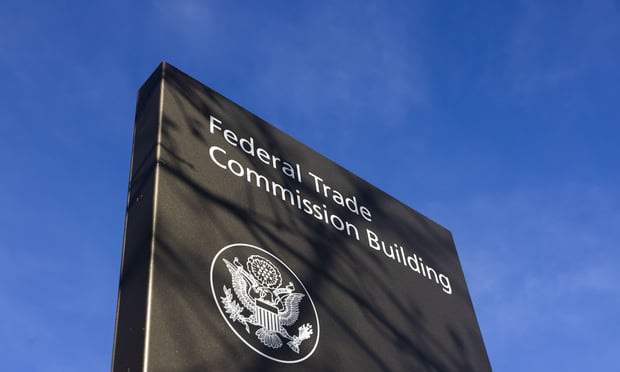 Arecent Treasury & Risk article described the resultsof a Deloitte survey as pointing to an “evolution” of the corporate treasurer “from number cruncher topartner in strategic decision-making.” That evolution isoccurring at the same time that shifts in currency exchange rates are having an increasingly serious impacton financial statements in every corner of theorganization.
Arecent Treasury & Risk article described the resultsof a Deloitte survey as pointing to an “evolution” of the corporate treasurer “from number cruncher topartner in strategic decision-making.” That evolution isoccurring at the same time that shifts in currency exchange rates are having an increasingly serious impacton financial statements in every corner of theorganization.
Volatility is way up this year in most major currencies. Andwhen, for example, the once-stable Swiss franc rises in value by 30 percent in a single day, thatswing will affect predictability and budgets from the C-suite tofinancial planning and analysis. Likewise, consider how theplummeting value of the euro would impact the supply chain andoperations teams in a company that is purchasing goods in poundssterling or dollars as inputs to a product that will sell ineuros.
|The value of a strategic corporate treasurer extends in bothdirections: A strategic treasurer can help each corporate functiontake currency risks into consideration when making decisions aroundsupply chain management, pricing and sales terms, outsourcing,expansion plans, and many other areas of the business. While at thesame time, when other corporate functions are consulting regularlywith the strategic treasurer, that dialogue gives treasury a morecomprehensive global view that helps with optimizing the managementof currency risk for the business overall.
|Building a Cross-Functional CurrencyRoundtable
|In the context of managing currency risk, whatdoes it mean to be a “strategic” treasurer? Over the course ofmore than a decade of work with hundreds of organizations, we'vefound that truly strategic treasurers tend to have five traits incommon:
- Strategic treasurers understand where in the organizationexposures are being created.
- They are empowered to impact company policy.
- They have access to accurate, complete, and timely data.
- They address currency volatility proactively, often answeringquestions before they're even asked.
- And, finally, they often pull together a “currency roundtable”that includes the right people to strategically consult from a widevariety of corporate functions.
This last point is crucial, and it represents the best practice in managing foreign exchange (FX) exposures. Anytreasurer of a multinational organization who's looking to make asubstantive contribution to the company's strategic decision-makingshould invite leaders from across the organization to participatein an ongoing collaborative dialogue about how currency isimpacting the company and how best to manage that risk. Thecurrency roundtable needs to include one or more representatives ofeach of these groups:
|Board of directors. Thecorporate board and its audit committee have a fiduciaryresponsibility to the company's shareholders. The personrepresenting the board on the currency roundtable brings to thetable a focus on issues around shareholder value, compliance, andthe company's risk tolerance.
|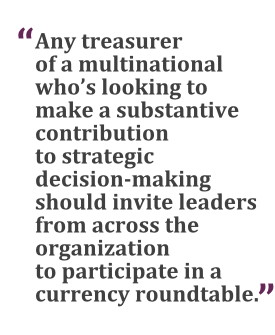 Thismember of the roundtable is part of the small group that definesrisk tolerance and has oversight responsibility to make sure allappropriate controls are in place to limit risk to shareholdervalue. So he or she should encourage the roundtable to answerquestions such as: Have we defined how much risk we're willing toaccept and set an associated risk management policy for theorganization? And are we effectively communicating the impact ofcurrency surprises on shareholder value to all of the relevantconstituents (investors, analysts, Wall Street, etc.)?
Thismember of the roundtable is part of the small group that definesrisk tolerance and has oversight responsibility to make sure allappropriate controls are in place to limit risk to shareholdervalue. So he or she should encourage the roundtable to answerquestions such as: Have we defined how much risk we're willing toaccept and set an associated risk management policy for theorganization? And are we effectively communicating the impact ofcurrency surprises on shareholder value to all of the relevantconstituents (investors, analysts, Wall Street, etc.)?
Executive management. The CEOand CFO are focused on business strategy and the overallperformance of the company. They embody what the level of risktolerance currently is, and what it will be on a go-forward basis,based on their understanding of future plans for operations. Theexecutive perspective is grounded in pure financial metrics.Because the buck stops with them in terms of currency impact, bothexecutives should have a seat at the currency roundtable.
|Their contributions to the discussion may touch on topics suchas corporate financial results, resource utilization, and theimpact of different currency considerations on specific businessunits. Both within the roundtable and in other settings, the CEOand CFO look to treasury to explain how currency volatility can beexpected to affect financial performance measures such as revenue,EBITDA, and earnings per share.
||
Accounting. The corporatecontroller is the custodian of the company's accounting data and isresponsible for disseminating that information throughout theorganization. Accounting managers are the rule-setters whodetermine which accounts get counted in and out from an exposureperspective. Representatives of accounting are at the currencyroundtable to provide insight into compliance and control issuesthat may arise due to currency volatility. When the company isimpacted by currency volatility, the controller must understandwhether the organization's financial results are an accuratereflection of what happened in the business, and whether theFX impact reflects a data integrity issue or is an outcome ofcurrency management. The currency roundtable is the right place topose these sometimes complex questions and to collaborate aroundsolutions to these problems.
|Regional finance teams. In eachregion where the company operates, there are likely local financeresources who are responsible for the performance of their entitiesor units. These individuals bring to the corporate currencyroundtable a ground-level understanding of their business. They areas close to the market as you can physically get and are thestakeholders with “tribal knowledge” that help build informedcurrency forecasts. Additionally, compensation for theseindividuals may change significantly depending on performance. As aresult, in some cases, currency swings affect the compensation ofthe local business leaders.
|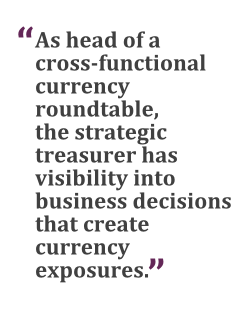 Regionalfinance teams are frequently grappling with the challenge ofdeploying appropriate resources to satisfy corporate reportingrequirements and meet the needs of business management aroundcurrency risk mitigation. The currency roundtable can give themmore of a bird's-eye visibility into organizational risks.
Regionalfinance teams are frequently grappling with the challenge ofdeploying appropriate resources to satisfy corporate reportingrequirements and meet the needs of business management aroundcurrency risk mitigation. The currency roundtable can give themmore of a bird's-eye visibility into organizational risks.
FP&A. Thefinancial planning and analysis team is responsible for explainingwhat has happened (impact analysis) and what could happen (scenarioanalysis) in the business. The person in this chair at theroundtable needs to work with the other participants to answerseveral key questions: To what degree did currency impact thecompany in the last month/quarter/etc.? How much of that impact wasvolume, and how much of it was rate? How much did currency issuesmove our actual reported results away from budget and forecasts? Ifa specific currency moves 5 percent in the next quarter, what riskwill that create for the organization? What if the currency moves10 percent?
|Supply chain and operations. This group is responsible for pricing, supplier contracts,production costs—and, ultimately, the profitability of each productline. The individual sitting in this chair at the currencyroundtable should focus on issues such as determining theproportion of the company's margin variance that results fromchanges in cost of materials, and the proportion driven by currencyvolatility.
|Tax. The taxfunction is responsible for minimizing the company's tax liability,and so is always looking to optimize tax strategy and tax impactson the business. Through that lens, members of the tax organizationcan have a profound effect on the company's currency strategy, asthey can also be impacted by currency. For example, intercompanytransactions designed to lower the corporate tax rate maysimultaneously create currency exposures. In this case, the taxmember of the roundtable would ask questions such as: Are thereother strategies operationally that we can apply to efficientlymanage this risk? What are the tax consequences of reducing thecurrency exposure by only X?
|Treasury. Through discussionswith representatives of all of these functions, the corporatetreasurer should lead the currency roundtable. In somecases—largely dependent on the size and complexity of thebusiness—the roundtable may include other members of treasury frontand/or back office as well, but at a minimum, the corporatetreasurer should be there.
|Treasury is responsible for having an accurate, complete, andtimely view of currency exposures and for managing the associatedrisk in accordance with company policy. Treasury responsibilitiesinclude seeking organic exposure reduction (e.g., netting) andfinding natural hedging opportunities. In order to meet thoseresponsibilities, the treasury team needs visibility into currencytrends and analytics that help define exposures, best accomplishedby using a software system that can scale up as the business growsin size and complexity.
|(See the sidebar Expertise at the Currency Roundtable on page 5.)
||
Each business leader at the currency roundtable is includedbecause his or her position is affected in some way by currencyvolatility—and each business leader makes decisions that may affectthe degree to which currency swings impact the financial statementsof the organization as a whole.
|Consider the Swedish subsidiary of a euro-reporting company thathad been buying and selling in krona, then switched to selling inRussian rubles while buying component parts from Germany in euros.Clearly, the decision to switch currencies could significantlyimpact the company's exposures. At what point should the treasurerbecome aware of that business decision? Ideally, before thebusiness decision was made, the idea would be discussed at thecurrency roundtable so that the cross-functional team coulddetermine its possible impacts and discuss its pros and cons.
|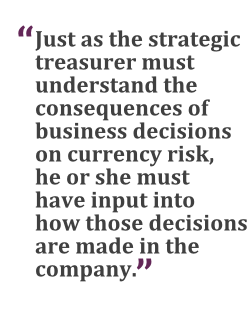 Recognizingthe importance of cross-functional collaboration, one global $820million company established a risk committee, the company'sversion of a currency roundtable. Representatives from treasury,tax, accounting, and legal all have seats. One of the primary goalsin establishing this risk committee was to arm participants withknowledge. Now the treasury team has a better understanding ofmulticurrency accounting processes within the organization, andindividuals across all the functional areas understand better howtheir decisions affect currency exposure.
Recognizingthe importance of cross-functional collaboration, one global $820million company established a risk committee, the company'sversion of a currency roundtable. Representatives from treasury,tax, accounting, and legal all have seats. One of the primary goalsin establishing this risk committee was to arm participants withknowledge. Now the treasury team has a better understanding ofmulticurrency accounting processes within the organization, andindividuals across all the functional areas understand better howtheir decisions affect currency exposure.
Timing and Agenda of Roundtable Meetings
|There is no prescriptive, one-size-fits-all process that worksfor organizing every currency roundtable. A variety of factorsaround a company's operations, and the currencies it's exposed to,affect how frequently the roundtable needs to meet. However, in ourobservation of currency roundtables in action, we've found thatmost meet at least quarterly, with some roundtable participantsholding smaller monthly meetings as well.
|The agenda for the quarterly meeting is usually framed aroundthat quarter's financial results and whether those results can befully explained. If the discussion raises issues that needinvestigating, or identifies obvious opportunities for improvement,actionable next steps will usually come out of the quarterlymeeting, to be followed up on at the next monthly meeting.Additionally, the most effective roundtable teams take an annualstep back to look at the year overall and to address any changesthat the company may need to make in its risk policies.
|Becoming a Strategic Treasurer
|As head of a cross-functional currency roundtable, the strategictreasurer has visibility into business decisions that createcurrency exposures, such as when an executive is considering doingbusiness in a currency other than the entity's functional currencyor the company's reporting currency.
|At one multinational Internet company, for example, treasury wasasked to mitigate currency risk without hedging. The treasurer hadto find exposure offsets and natural hedging opportunities. And tofind those, he had to understand where the organization wasconducting business in currencies other than the functional orreporting currency. The treasury team dug into the company'scross-currency transactions and found that intercompanytransactions were creating significant exposure. In response, thecompany's currency roundtable made the decision to set up anintercompany bank and developed a policy of netting exposures morefrequently.
|Just as the strategic treasurer must understand the consequencesof business decisions on currency risk, he or she must have inputinto how those decisions are made in the company, and into othercorporate policies that affect currency.
||Sometimes this input might take the form of a proscription—e.g.,“Entities shall not sign contracts denominated in a currency otherthan the functional currency.” Other times, it may take the form ofestablished guidelines. For example, because one of the chiefcauses of multicurrency data-integrity issues is the improper setup ofnew entities, well-documented processes to ensure that new entitiesare set up according to policy are essential. A strategic treasureris empowered to develop, implement, and enforce those policies.
|Another possibility is that the strategic treasurer's impact oncompany policy might take the form of a process that requirestreasury to be consulted when certain types of decisions are beingconsidered. Then the treasurer can share with the business leaderthe cost of the decision, perhaps in terms of the hedge required tooffset the exposure created. With a complete understanding of theconsequences, the business leader can make a fully informeddecision.
|Regardless of the form that his or her input takes, a strategictreasurer looking to advise other corporate leaders on decisionswith currency impacts can rely on the currency roundtable forinformation and support. At one global manufacturer, for example,when the treasury team analyzed the drivers of currency exposure,they found that intercompany sales were being recorded at thebudgeted exchange rate. That policy sometimes created significantpurchase price variance; depending on how currencies moved, salesrevenue could miss targets by 30 percent. The treasurer broughtthat insight to the currency roundtable, which came up with policychange recommendations and then presented those suggestions to thecompany's CEO and CFO.
|How to Get There
|I've heard many treasurers say that managing currency risk feelslike entering a gunfight with no bullets. They don't own thedata—accounting does—and they may not even be invited to thedecision-making table. One treasurer recently told me that at herorganization currency-related decisions are driven by the tax team.The company considers what works best for tax planning, and thetreasurer is not empowered to even sit at her own currencyroundtable.
|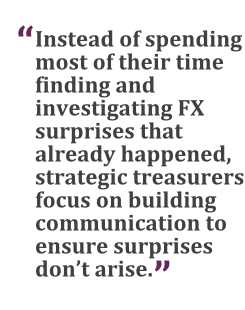 Tolead currency discussions, the treasurer must be armed withinsights; data is the treasurer's ammunition. For example, duringthe euro crisis, the treasurer at a multinational technologycompany had the data and the analytic capability necessary to guidethe company through the crisis with minimal impact on earnings pershare (EPS). His performance during this difficult time earned hima seat at the head of the currency roundtable, and the ability toinfluence policy.
Tolead currency discussions, the treasurer must be armed withinsights; data is the treasurer's ammunition. For example, duringthe euro crisis, the treasurer at a multinational technologycompany had the data and the analytic capability necessary to guidethe company through the crisis with minimal impact on earnings pershare (EPS). His performance during this difficult time earned hima seat at the head of the currency roundtable, and the ability toinfluence policy.
Strategic treasurers need to go into every currency roundtablemeeting armed with accurate, complete, and timely exposure data andanalytics. Big-data analytics tools enable the strategic treasurerto analyze the data in a way that is in line with other businessfunctions—so treasury staff can have informed, groundedconversations with those stakeholders. They can explain the riskbehind decisions, and they can make recommendations for onedecision over another based on what their data-driven models tellthem might be the impact.
|At one $1.5 billion global software company, for example, theassistanttreasurer hosts a monthly meeting attended by representativesfrom treasury, accounting, and tax, in which the group discussesrelevant intercompany activity. For his part of the currencyroundtable agenda, the assistant treasurer uses exposure analyticsdata to solicit information about the business context of specificexposures across the company, such as large intercompany balances.He talks about each business unit as having one piece of thecurrency risk puzzle, and that all units have to coordinatetogether to see the complete picture.
|Addressing Volatility in Real Time
|When strategic treasurers have brought the right people to thecurrency roundtable, when they understand where in the organizationexposures are being created, when they are empowered to impactcompany policy, and when they can depend on accurate, complete, andtimely data—then they are prepared to address currency volatilityin real time.
|The treasurer of a $600 million global tech company shared agreat story with me the other day. He tries to beat his CFO to newsabout currency moves. The morning after the euro fell 1.3 percentversus the dollar, this treasurer pulled a list of the company'seuro exposures; analyzed how, based on those exposures, the euro'smove could impact the company; determined per company policy whattrades needed to be made; and delivered an email articulating itall to the CFO before he had finished his first cup of coffee.
|As in this example, the strategic treasurer is a true adviser tothe CEO and CFO. It's the treasurer's job to ensure senior managersdon't get blindsided by currency surprises or questions they aren'tprepared to answer. Instead of spending most of their time findingand investigating FX surprises that already happened, strategictreasurers focus on building communication and processes to ensuresurprises don't arise.
|———————————–
| AndyGage is vice president of strategic market developmentand global head of research at FiREapps, a firm thathelps treasury and finance professionals understand and managecurrency exposure and impact to financial results. To that end,companies ranging from Accenture to Yahoo use FiREapps FX analyticsto monitor and manage the impact of currency volatility on theirbusiness.
AndyGage is vice president of strategic market developmentand global head of research at FiREapps, a firm thathelps treasury and finance professionals understand and managecurrency exposure and impact to financial results. To that end,companies ranging from Accenture to Yahoo use FiREapps FX analyticsto monitor and manage the impact of currency volatility on theirbusiness.
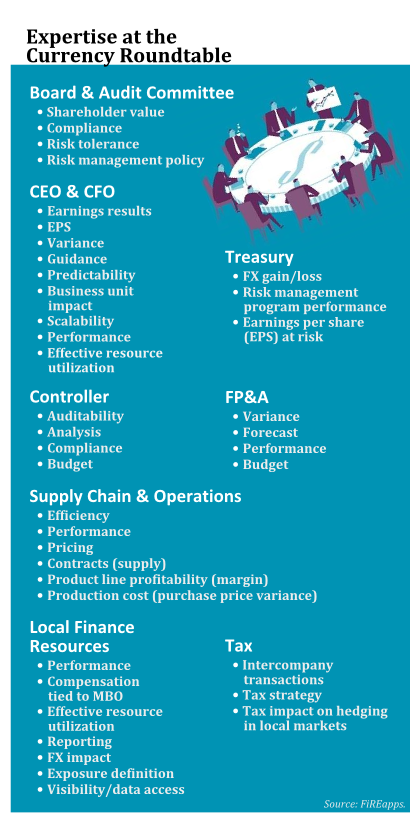
Complete your profile to continue reading and get FREE access to Treasury & Risk, part of your ALM digital membership.
Your access to unlimited Treasury & Risk content isn’t changing.
Once you are an ALM digital member, you’ll receive:
- Critical Treasury & Risk information including in-depth analysis of treasury and finance best practices, case studies with corporate innovators, informative newsletters, educational webcasts and videos, and resources from industry leaders.
- Exclusive discounts on ALM and Treasury & Risk events.
- Access to other award-winning ALM websites including PropertyCasualty360.com and Law.com.
*May exclude premium content
Already have an account? Sign In
© 2024 ALM Global, LLC, All Rights Reserved. Request academic re-use from www.copyright.com. All other uses, submit a request to [email protected]. For more information visit Asset & Logo Licensing.




